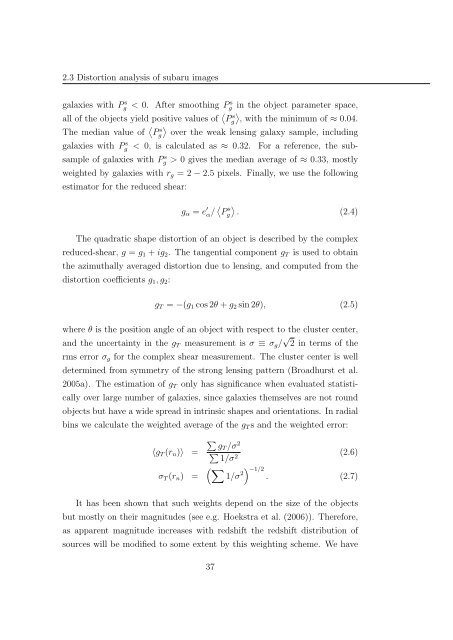Mass and Light distributions in Clusters of Galaxies - Henry A ...
Mass and Light distributions in Clusters of Galaxies - Henry A ...
Mass and Light distributions in Clusters of Galaxies - Henry A ...
Create successful ePaper yourself
Turn your PDF publications into a flip-book with our unique Google optimized e-Paper software.
2.3 Distortion analysis <strong>of</strong> subaru images<br />
galaxies with Pg s < 0. After smooth<strong>in</strong>g s <strong>in</strong> the object parameter space,<br />
all <strong>of</strong> the objects yield positive values <strong>of</strong> 〈 Pg〉 s , with the m<strong>in</strong>imum <strong>of</strong> ≈ 0.04.<br />
The median value <strong>of</strong> 〈 Pg〉 s over the weak lens<strong>in</strong>g galaxy sample, <strong>in</strong>clud<strong>in</strong>g<br />
galaxies with Pg s < 0, is calculated as ≈ 0.32. For a reference, the subsample<br />
<strong>of</strong> galaxies with Pg s > 0 gives the median average <strong>of</strong> ≈ 0.33, mostly<br />
weighted by galaxies with r g = 2 − 2.5 pixels. F<strong>in</strong>ally, we use the follow<strong>in</strong>g<br />
estimator for the reduced shear:<br />
g α = e ′ α/ 〈 P s g〉<br />
. (2.4)<br />
The quadratic shape distortion <strong>of</strong> an object is described by the complex<br />
reduced-shear, g = g 1 + ig 2 . The tangential component g T is used to obta<strong>in</strong><br />
the azimuthally averaged distortion due to lens<strong>in</strong>g, <strong>and</strong> computed from the<br />
distortion coefficients g 1 , g 2 :<br />
g T = −(g 1 cos 2θ + g 2 s<strong>in</strong> 2θ), (2.5)<br />
where θ is the position angle <strong>of</strong> an object with respect to the cluster center,<br />
<strong>and</strong> the uncerta<strong>in</strong>ty <strong>in</strong> the g T measurement is σ ≡ σ g / √ 2 <strong>in</strong> terms <strong>of</strong> the<br />
rms error σ g for the complex shear measurement. The cluster center is well<br />
determ<strong>in</strong>ed from symmetry <strong>of</strong> the strong lens<strong>in</strong>g pattern (Broadhurst et al.<br />
2005a). The estimation <strong>of</strong> g T only has significance when evaluated statistically<br />
over large number <strong>of</strong> galaxies, s<strong>in</strong>ce galaxies themselves are not round<br />
objects but have a wide spread <strong>in</strong> <strong>in</strong>tr<strong>in</strong>sic shapes <strong>and</strong> orientations. In radial<br />
b<strong>in</strong>s we calculate the weighted average <strong>of</strong> the g T s <strong>and</strong> the weighted error:<br />
〈g T (r n )〉 =<br />
∑<br />
gT /σ 2<br />
∑ 1/σ<br />
2<br />
(2.6)<br />
σ T (r n ) =<br />
(∑ ) −1/2<br />
1/σ<br />
2 . (2.7)<br />
It has been shown that such weights depend on the size <strong>of</strong> the objects<br />
but mostly on their magnitudes (see e.g. Hoekstra et al. (2006)). Therefore,<br />
as apparent magnitude <strong>in</strong>creases with redshift the redshift distribution <strong>of</strong><br />
sources will be modified to some extent by this weight<strong>in</strong>g scheme. We have<br />
37
















